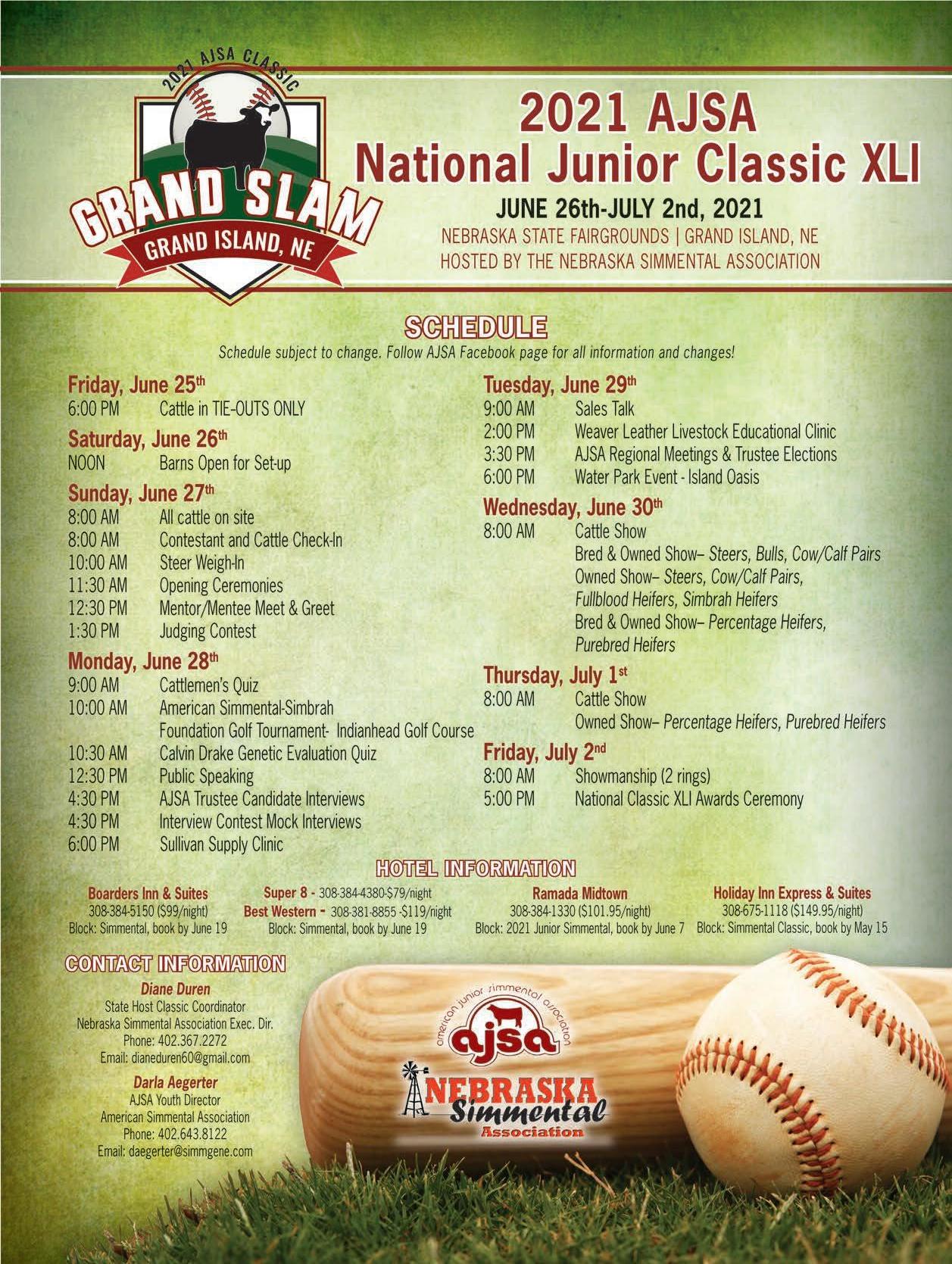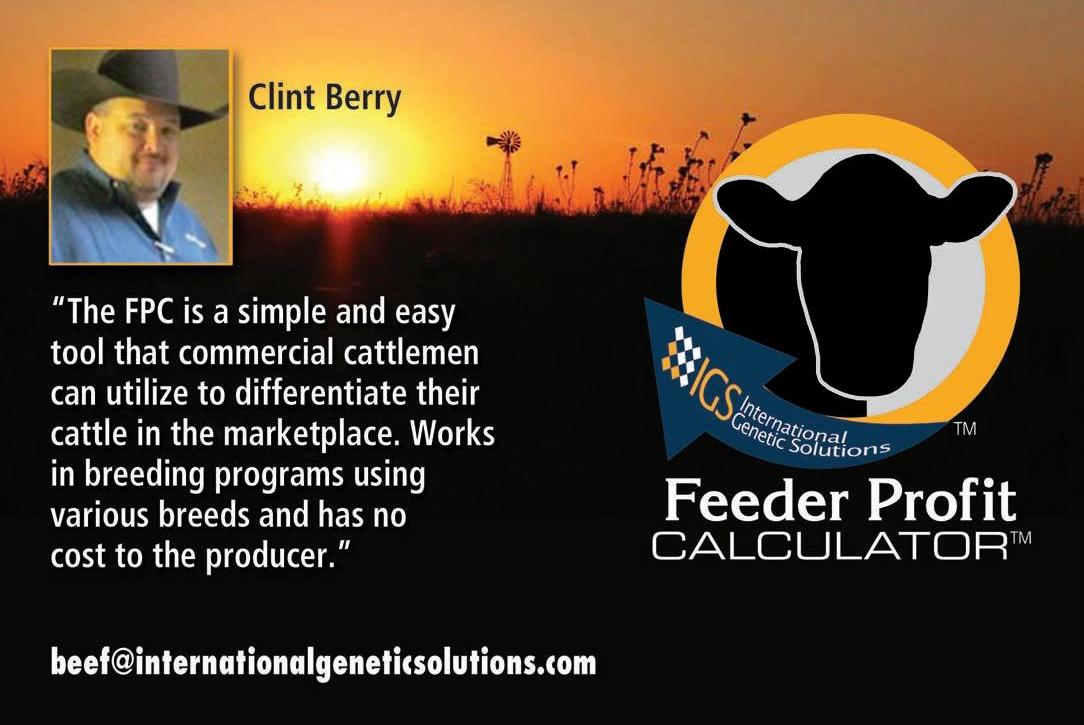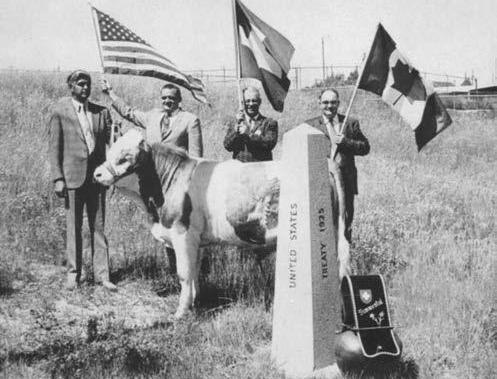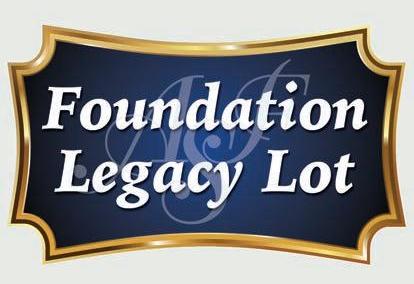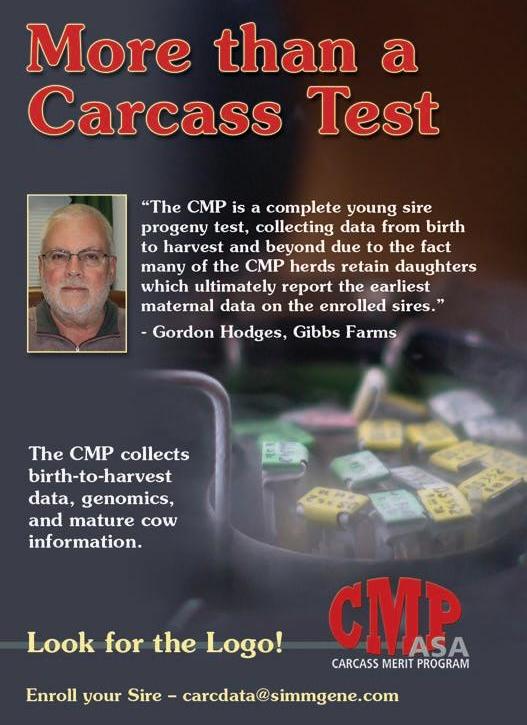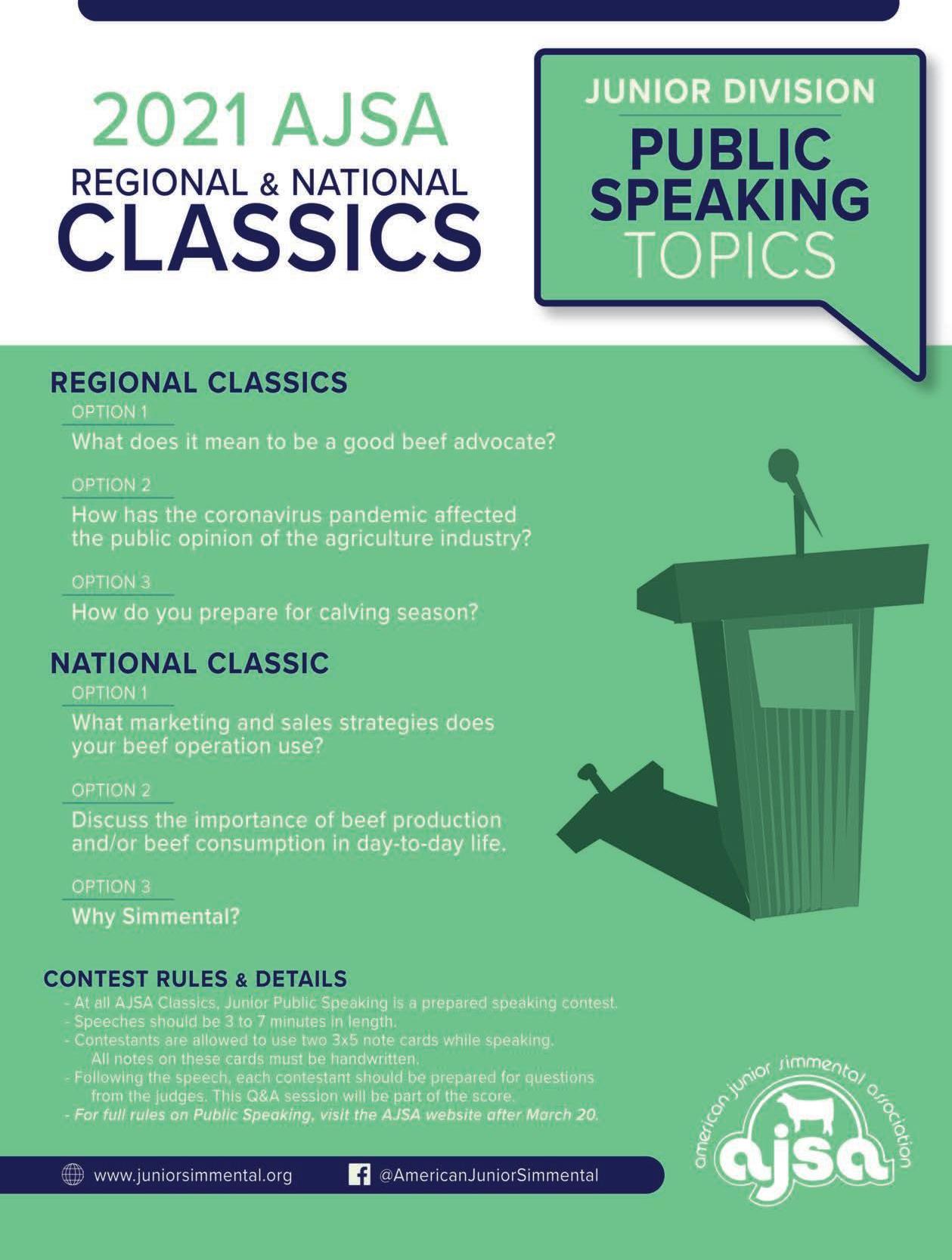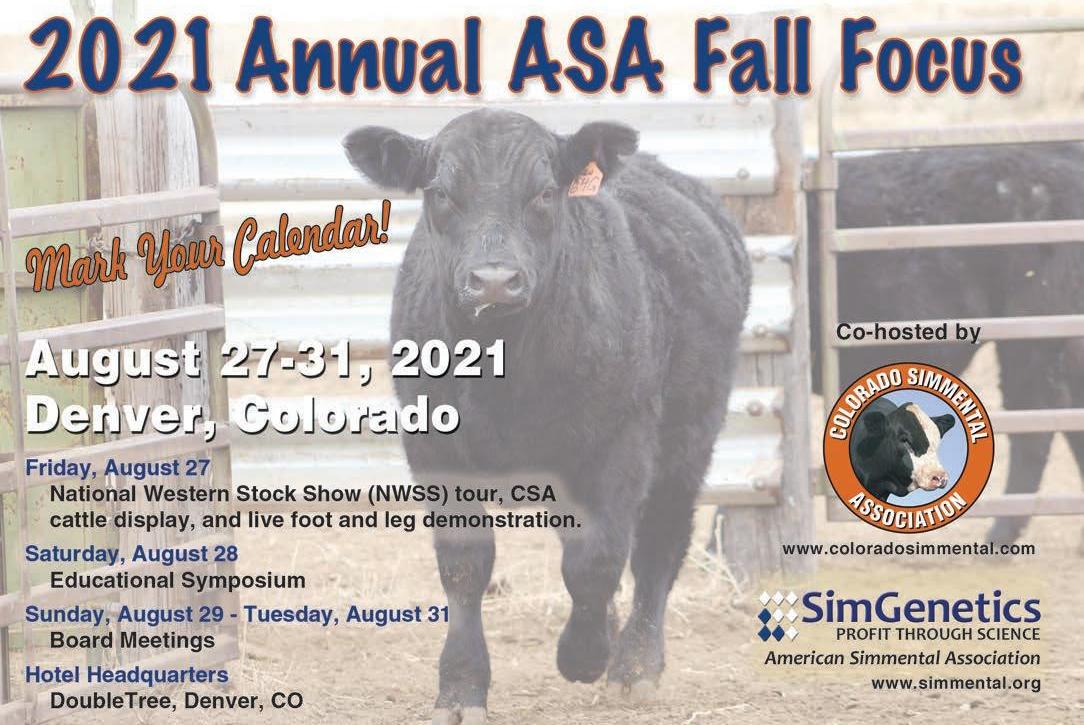
40 minute read
From the Headquarters
by Jannine Story Director of Performance Data Programs
The past year was certainly a trying year for everyone. Many found themselves struggling to keep up, whether they had a secular job outside the farm, taking care of family or just dealing with the repercussions of COVID. Many have found it challenging to collect data and get it submitted.
There are many ways for Total Herd Enrollment herds to track where one is at in reporting data, the quickest being the Inventory tab under Data Entry / Online. You can see quickly what has been submitted and what has not been. It is more of a bird’s-eye view.
If you want to see what data has been reported to each animal, then you go to Herd Mgmt / Reports, select the Inventory tab, enter the year and season, leave Performance Advocacy ALL and select the Performance Advocate report on the right. This will show you what has been reported to each dam, what data is reported for each calf and what potentially could be missing.
Why do I mention this? As a breed association, we are receiving about 90% of birth records of calves reported, whereas weaning drops to about 60% and yearling drops to about 25%. There is no doubt weaning and yearling data are the most difficult to collect when managing each year’s calf crop. What can you do as a breeder? We know many of you do not retain all of your calves through to yearling time; however, when you are weaning, can you weigh all of the calves, even if you are going to cull them? It definitely affects the ratio and ranking of the calves against each other and their EPDs. Are you using the calf removal codes correctly? Be sure you pay attention to preweaning versus post-weaning removal codes. If the calves go to a feedlot, is it possible to ask for the weights when near to yearling time? Or if they go into a feed intake program, can you get weights that are close to yearling time? By submitting complete contemporary group records, you give the most complete information about the genetic potential in your herd.
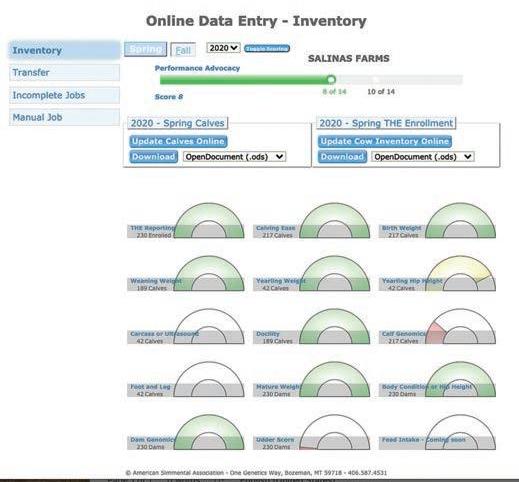
For this Total Herd Enrollment herd, they would be considered a score 8 of the Driven Performance Advocate, but they have holes in their data at Yearling Hip Height, Calf Genomics, and dam Udder Score. For more information on the Performance Advocate program, go to page 28.
Phenotypic data is still critical to the evaluation. The evaluation only knows what you tell it. So, what is it that I want to happen? I am asking all to put forth an effort to report all the weaning and yearling data, and if the calf left the herd, be sure you use the correct calf removal code. How can ASA help? Is it a matter of time to get the data entered? We can help. If you have entered it into a software or spreadsheet, send the extracted data or your spreadsheet to the@simmgene.com and we will help you get the data in. If the calves have already been reported and you are entering weaning or yearling, as long as it links to each animal tattoo (the way the animal is reported in our database), we can upload the data to each animal for you. If it is brand new calf data, then you need to be sure and supply all required data to report animals. It is best if it is an .xls or .csv format for us to be able to work with the data. We are here to help you get the most out of your records, whether it is helping you get the data into the database or helping you create reports to utilize the data you entered. ■
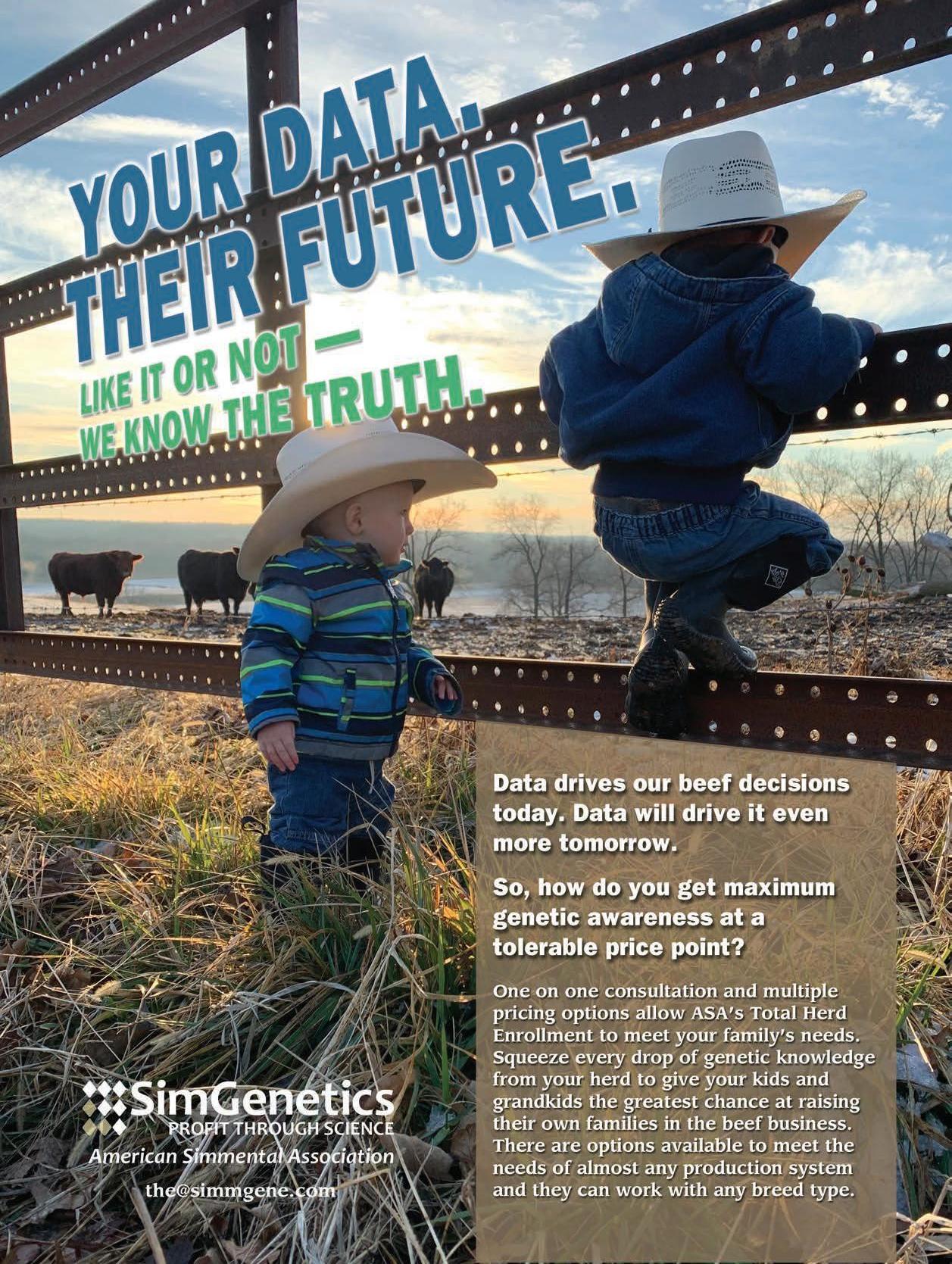
The Bichler family homesteaded on the original farm 101 years ago and it has since been handed down through the generations. Simmental has been a part of the operation since the breed was brought to North America. Doug’s father was one of the first in North Dakota to use a Simmental bull on his commercial cow herd. Doug explains, “My dad got a Simmental bull very early on when they were imported here. We’ve had them ever since. I know a lot of the commercial producers here were wanting something to use on their Hereford cows to add more performance — to just simply add more weight and muscle to their calves — and the producers that tried them early on were very happy with what they did on the Hereford cows and with the performance. Simmental genetics just took off from there.” Doug’s father worked alongside his father before taking over the business, and Doug followed the same path. At 16, he obtained his first two Simmental females and began building his herd. He knew at an early age that he wanted to move into the seedstock business. He remembers, “I’ve always had an interest in breeding seedstock cattle, particularly Simmental, and pursued that interest more seriously in college.”
In 2000, Doug purchased a larger group of females and started selling registered bulls the next year. His interest in developing quality seedstock has continued to grow over the years, and sticking with Simmental has been an obvious choice. “Something you’ll see run through our program is balance and consistency,” he says. “The Simmental cattle are so well balanced. They’re a performance breed, but you can’t beat the maternal that you get. We have found that the foot quality, udder quality, docility, and performance you get out of Simmental is just not matched by any of the other breeds we’ve worked with.”
A Steady Approach
Doug explains that his breeding philosophy boils down to one word: balance. He says, “I don't chase a single trait. I try not to chase fads. I try to make the most educated decision when I bring in a new bull or female, or utilize a bull or female in AI or ET. Whenever I buy a herd bull I try to look at it with a balanced approach.” Constantly improving his cow herd year to year is a priority for Doug and he makes careful decisions to ensure that nothing forces him to take a step backward. “I want to make sure whatever I use or bring in is going to propel me forward, and of course I look at cow families. There’s a lot of homework that goes into it. I approach it with a balanced state of mind because I want to market to everyone. I want my cattle to have good numbers, but I also want a phenotype that my commercial customers desire, with a lot of depth of body, rib shape, muscle, and performance.”
(Continued on page 14)
Bichler Simmentals sells bred females in November.
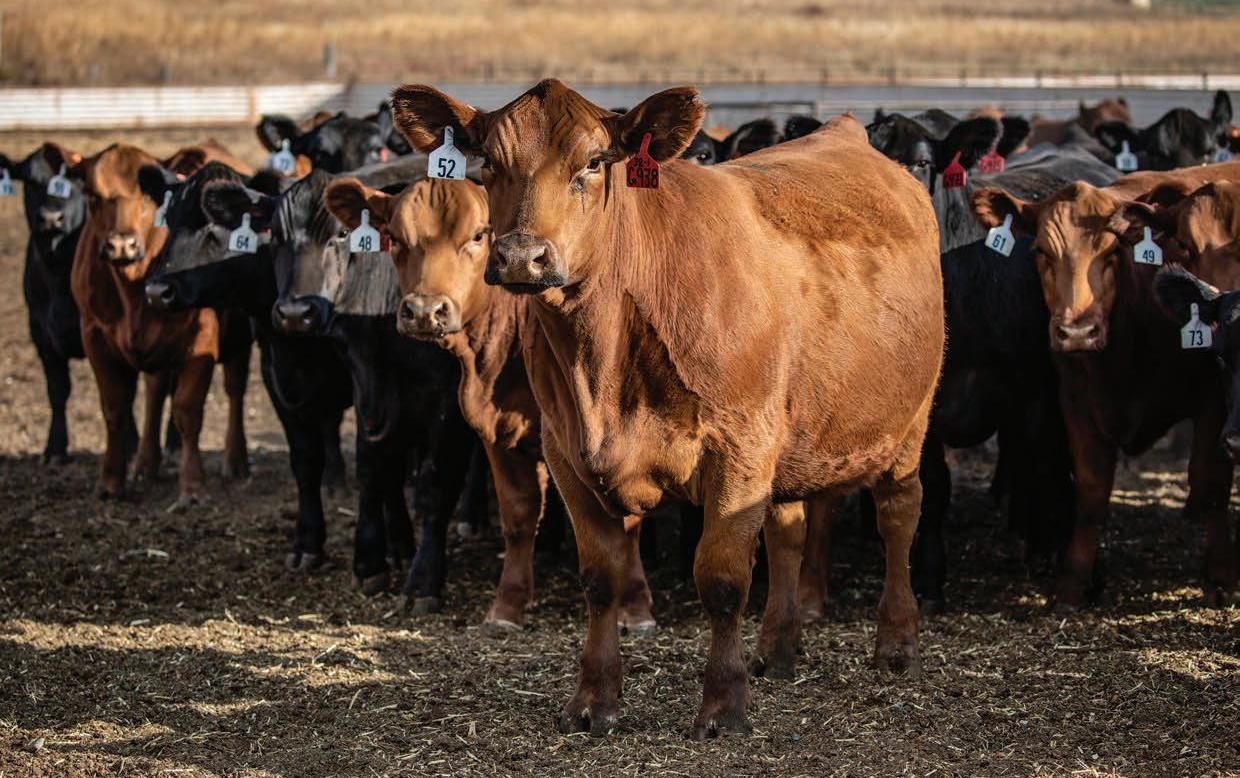
(Continued from page 13)
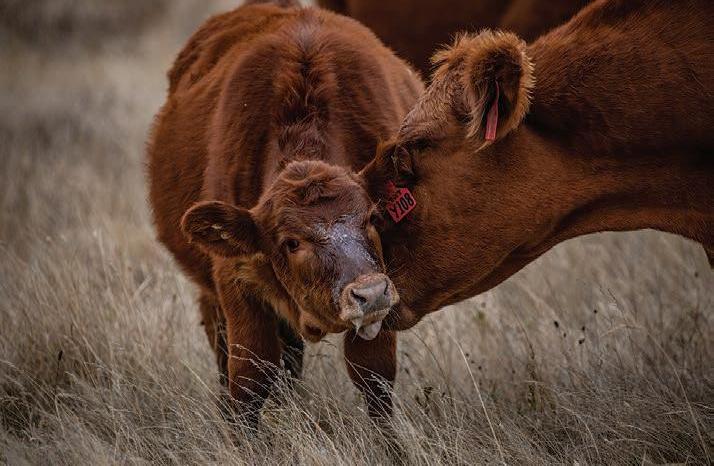
Maternal traits are a quality of the Simmental breed Doug appreciates.
Bichler Simmentals develops both black and red SimGenetics bulls to fit all of their customers’ needs
The Bichler family also has a custom feeding business. Using a variety of tools also allows the Bichler family to focus on balance. Genomics, carcass ultrasound, Total Herd Enrollment, and research projects are some of the ways Doug gathers information to make his own selection decisions, and also to give his customers the information they need to purchase the best bulls and females for their operations. Knowing how to use these tools, and also help his customers sift through this data, is a priority for Doug. He says, “When there are educational opportunities, I try to attend when I can. Obviously on a ranch setting it’s a little harder to get away, but I do appreciate the fact that there are other opportunities for me online. I like to watch tutorials, I like to learn about other producers and what they are doing, and I might come away with a new idea or a new way to approach something.” Genetic selection is something Doug has always enjoyed, and in recent years, he has moved toward using higher-quality herd bulls, more embryo transfer work, and less AI. Any females that don’t perform well, or don’t produce the kind of bulls and females Doug wants to sell, are moved to the recipient herd. Doug looks for new herd bulls throughout the year and is focused on finding sires that help advance the genetics of his herd. He explains, “They need to be phenotypically impressive to me. Things that are now more important are foot quality, disposition, and structural correctness. Those are big things I think our breed needs to focus on. I still want them to have some muscle and eye appeal, and work for me from an EPD standpoint.”
Bichler Simmental bulls are sold across the country, and one of Doug’s goals is to expand his customer base. North Dakota’s climate creates hardy cattle that can perform in a variety of environments. Doug says, “My customers who have added Simmental females to their herd, have used my bulls, and have had calves out of them have been really happy with how those cattle perform. It tells me I’m doing the right thing and doing something good. The Simmental cattle have been working very well for the cow herds we have around here. The SimAngus™ females are phenomenal. I hear that from my customers all the time, and I think the quality of the cattle that you get from incorporating Simmental genetics is second to none.
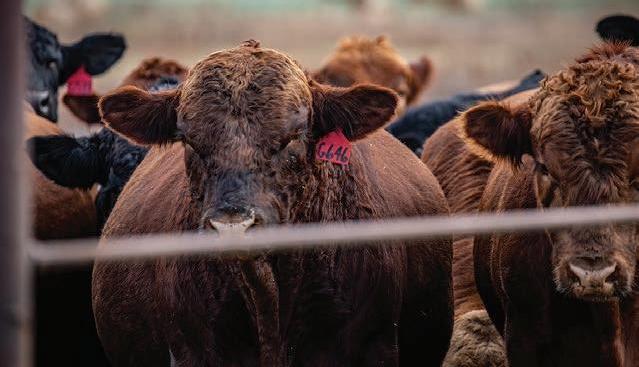
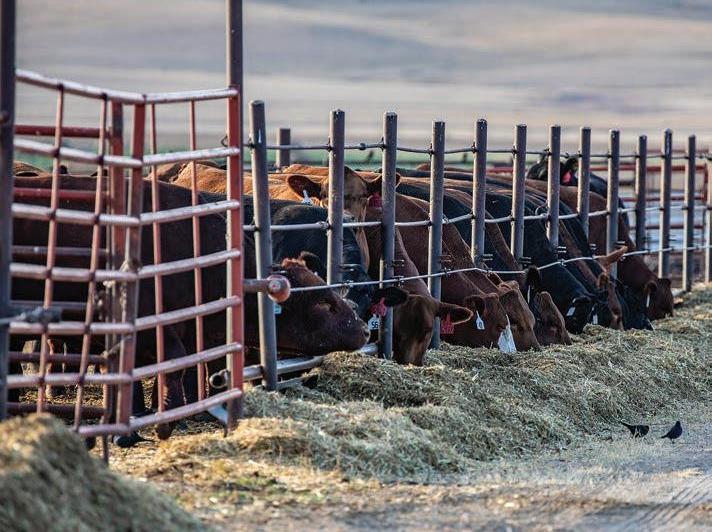
Overcoming Obstacles
The cattle business is fraught with unknowns — from mother nature to markets, each year comes with a new set of challenges. The Bichler family was faced with an especially difficult situation several years ago when Doug was in a farm accident. While cleaning out the baler to begin in the field, he grabbed at one last piece of net wrap and before he realized what was happening, his arm was sucked into the moving belts. He was stuck there for some time, became unconscious, and was eventually jolted awake because the collar of his shirt was also being sucked in. A rush of adrenalin allowed him to pull his arm out. Maria, who was pregnant with their first child, had fallen asleep in the house waiting for Doug to come in for dinner. Doug was able to wrap his arm up, get inside, and call 911. This led to his right arm being amputated above the elbow and a three-week stay in the hospital.
Farming and ranching is ranked in the top ten most dangerous jobs by the US Bureau of Labor Statistics Census of Fatal Occupational Injuries, and raising awareness about safety is a priority for the industry. While the incident caused a number of immediate challenges, like healing and raising a new child at the same time, Doug has been able to continue working on the ranch and has found a positive outlook on the situation. “I still feel fortunate. I can still hold my kids, and I can still be around for them. It could have been so much worse and I’m thankful to still be here,” he says. “People think twice about things that they do and to me that’s kind of what makes it worth telling my story, because if I can help someone avoid what happened to me, it makes it a little more worth it to me in the end.”
The cow herd has also helped the Bichlers to adjust and succeed in the face of this challenge. North Dakota winters are harsh, and calving season can be a constant fight with mother nature. To remove this stress and reduce labor, Doug moved to calving in May, and will be selling his second group of 18-month-old bulls this coming November. Previously, the Bichler’s sale was held in February. Doug explains, “I needed a way for this cow herd to help me out a little bit, and to work with mother nature, instead of always seeming to work against it. So, I came up with the idea of calving later so I could have the cows out in more of a natural setting. The cows all calve out on grass now. It went tremendously well, it accomplished my goal, the calves were very healthy, and the cows were in great shape. I had very little dystocia. It just changed things in a way that gave me new optimism that I can still pursue my goals and my dreams in this industry even though things look a little different. The cow herd worked for me and did really well. Because of that I also changed my approach to selling cattle.” (Continued on page 16)
The North Dakota rangeland is an extremely productive place to raise cattle.

Bichler takes a lot of pride in the daily care of his cow herd.
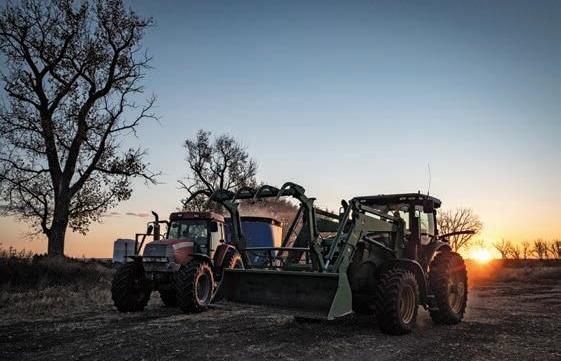
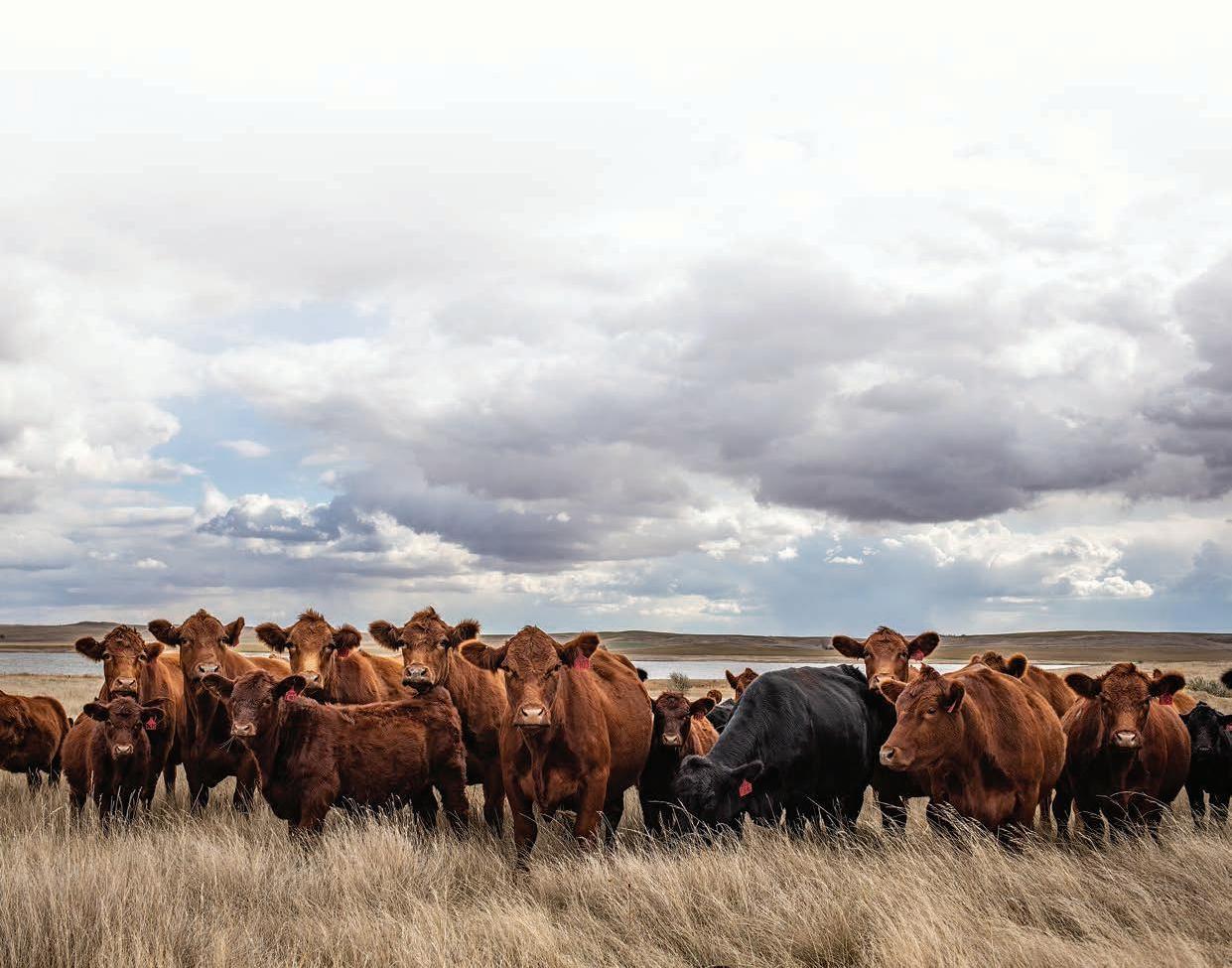
(Continued from page 15)
A Family and Community Business
Raising a family in agriculture is a priority for Doug and Maria. Their two daughters, Amelia, 3, and Therez, 1, are already taking great interest in the cow herd and Doug finds a lot of joy in sharing daily farm life with them. Maria works from home as a journalist and also spends a lot of time helping Doug on the farm.
North Dakota is also important to the Bichler family. Doug and Maria both have deep roots in the state and find a lot of value in being a part of their rural community. Maria says, “We love where we live. North Dakota in general is filled with good people and good cattle.” Doug represented the Simmental breed at the Young Cattlemen’s Conference, and says this experience, in addition to other industry events, have been important to him. “I met a lot of great people, and I’m still in contact with several of them. To this day we check in with them frequently.” He is generally very involved in his community and the industry, and his driven nature has allowed him to make progress in the seedstock industry. “I’ve always been very determined and very goal oriented,” Doug says. “Honestly, I’ve heard all of my life that ‘you can’t do that,’ or ‘that’s not going to work,’ and it seems like that drives me to not only do a good job, but to do better than I’m expected to do. That’s been the theme of my whole life, really. You need to figure out what your goals are, and put your head down and work toward those goals. Some days will be tough, but if you stay the course and realize what your goals are and put the work in, then I think you can be successful.” In the future, Doug says he will continue to work toward raising the best cattle he can. “I want to be able to sustain my family here, and sustain a good way of living as I have in the past. I want to increase the quality of the cattle we have. I think there is always room for improvement no matter how good your cow herd is. There is always something to fix, and I’m just going to keep working toward that perfect cow I have in my mind.” He concludes, “I feel incredibly blessed to be able to take care of this cow herd every day. My way of life is something I wouldn’t trade for anything. I enjoy feeding every day, and seeing how far I’ve come. Now, being able to have my wife and kids out here with me, there is no occupation that is more rewarding than being able to pass this onto the next generation.” ■
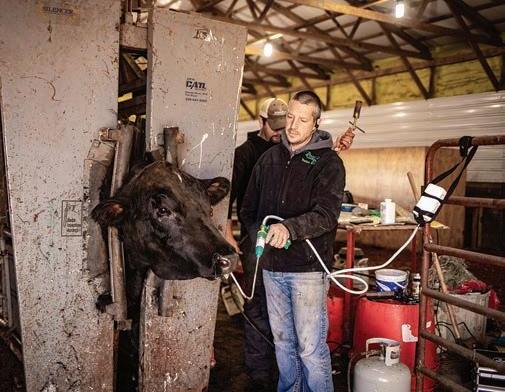
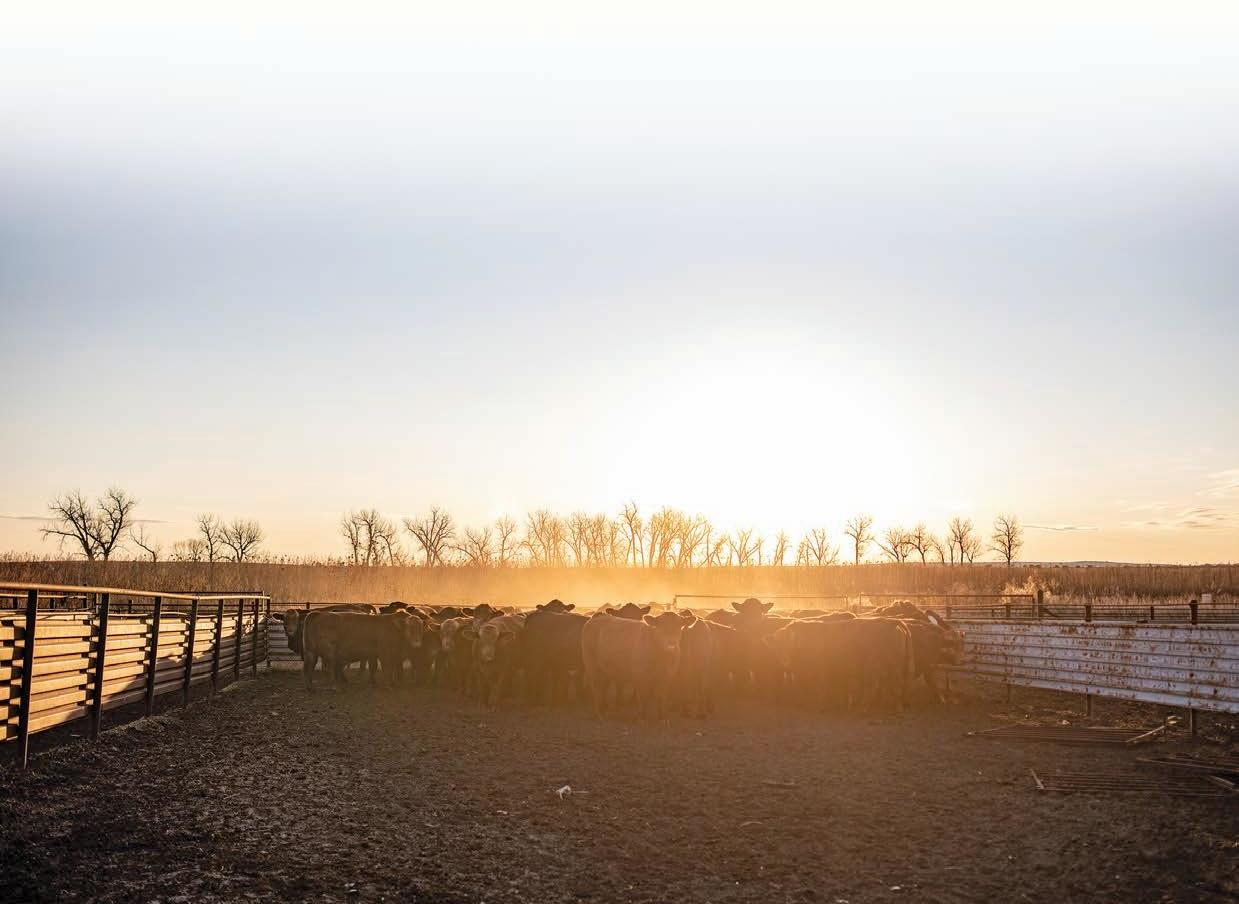
The Bichler family develops all of their bulls and females on site.
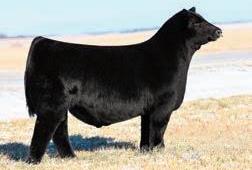
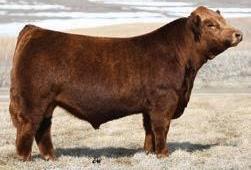
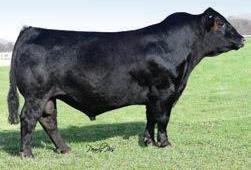
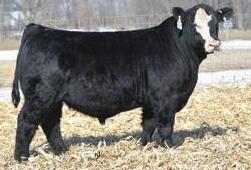
$API: 138 $TI: 82
Long`s Red Answer H8
W/C Hoc HCC Red Answer 33B x
WS Prime Beef Z8 ASA# 3784793 • Red • Homo Polled Exciting, complete, homo polled, rare Red Answer son!
$API: 149 $TI: 86
Mr SR Mic Drop G1534
Mr SR 71 Right Now E1538 x
JBS Big Casino 336Y ASA# 3568352 • Homo Black • Homo Polled A true spread bull with extra MCE, Docility, Marbling and production profit potential.
$API: 166 $TI: 103
WS Proclamation E202
CCR Cowboy But 5048Z x WS Miss Sugar C4 ASA# 3254156 • Homo Black • Homo Polled Proclamation is one of the ELITE, must-use superstars!
$API: 119 $TI: 84
Rocking P Vintage H008
Pays To Believe x Quantum Leap ASA# 3772248• Black • Polled 2021 Cattlemen’s Congress Division Champion! COOL!
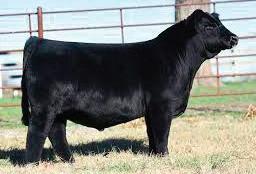
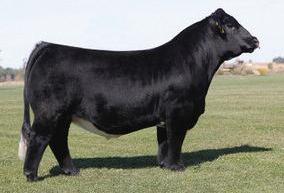

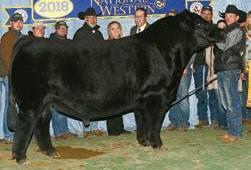
$API: 110 $TI: 74
SC Pay the Price C11
Pays to Dream x Trademark ASA# 2988788 • Homo black • Hetero polled Two-time NWSS Grand Champion Bull
$API: 108 $TI: 76
WCL No Limits G302
Mr. CCF 20-20 x American Pride ASA# 3659712• Homo black • Homo polled No Limits is a neat patterned bull out of the legendary 20-20!
$API: 118 $TI: 75
Mr CCF Clarified E3
Mr CCF 20-20 x
Miss CCF Sheza Superstar by Duracell ASA# 3275273• Homo black • Homo polled Backed by the Louisville and Denver Champion Sheza Bonnie, Clarified offers elite phenotype, proven genetics, and a balanced EPD profile.
$API: 128 $TI: 74
OBCC CMFM Deplorabull D148
W/C Executive Order x LazyH/Adkins Blkstr Z15 ASA# 3150188 • Homo Black • Homo Polled Newly on the open market for 2021! Deplorabull is the $100,000 valued herd sire prospect that was the talk of Kansas City and Louisville in the fall of 2016. He was named Bull Calf Champion at both the American Royal and the NAILE.
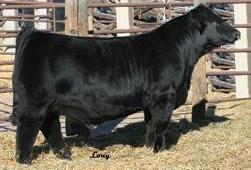
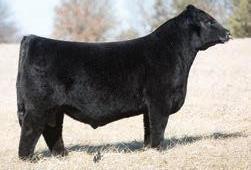
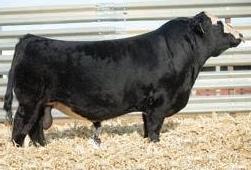
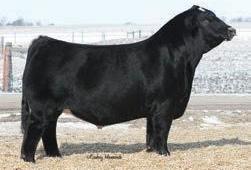
$API: 117 $TI: 81

GSC GCCO Dew North 102C
Duracell x Dew It Right ASA# 3141837 • Homo black • Homo polled Calving ease combined with tremendous structural soundness! 2018 Fort Worth Champion!
$API: 109 $TI: 81

Longs Pay the Man E16
Pays to Believe x Shear Pleasure ASA# 3327014 • Homo black • Homo polled Great-built, stout, double-homozygous Pays to Believe son!
$API: 129 $TI: 87
LLSF Vantage Point F398
CCR Anchor x Uprising x Quantum Leap’s Dam ASA# 3492381 • Hetero Black • Homo Polled 3/4 Lead-off Bull in the 2019 NWSS Champion % for Lee.
$API: 110 $TI: 72
Felt Perseverance 302F
W/C Executive Order 8543B x Rubys Rhythm Z231 ASA# 3493800 • Hetero Black • Homo Polled Perseverance is a new, exciting baldy Executive Order son with tremendous maternal genetics behind him. The first dozen calves out of him have been born light and easily out of first calf heifers.
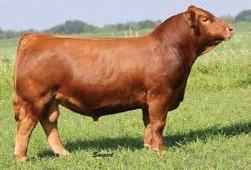
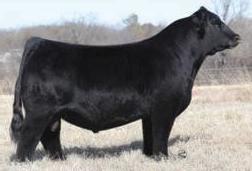
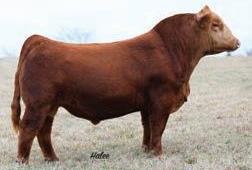
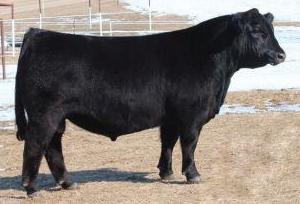
$API: 120 $TI: 81
W/C VIP 005G
CDI CEO x 8543U (Dream Catcher) ASA# 3644998 • Homo black • Homo polled $120,000 high seller from Wernings production sale.
$API: 118 $TI: 70
WHF/JS/CCS Double Up G365
W/C Double Down x WHF Summer 365C ASA# 3658592 Double Up is by proven calving ease sensation Double Down out of the legendary WHF/Steenhoek multiple time champion WHF Summer 365C.
$API: 133 $TI: 78
VOLK Backdraft CC F810
W/C Executive Order 8543B x JS Flatout Flirty ASA# 3528566 • Red • Polled Backdraft owns unrivaled maternal strength, combining infamous breed-leaders “Flatout Flirty” and “Miss Werning KP 8543U”.
$API: 114 $TI: 74
PBF Red Paint F88
W/C Executive Order x Built Right ASA# 3500551 • Red • Polled Hot, red, calving ease bull. 2019 Iowa State Fair Division Champion!
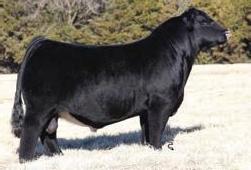
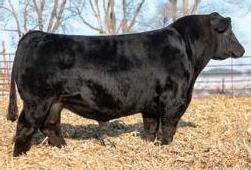
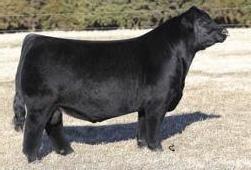
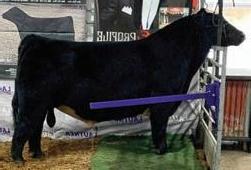
$API: 118 $TI: 70
KSIG Steelin His Style 6D
Silveiras Style x Steel Force x SS Babys Breath ASA# 3130639 • Homo black • Homo polled 1/2 SimAngus™, calving ease from the 2012 American Royal Champion!
$API: 40 $TI: 86
GEFF County O 736E
Loaded Up x RAJE/PB Montecito 63W ASA# 3289219 • Hetero Black • Homo Polled County O goes back to the Rhythm donor at Ruby’s! He’s a featured herdsire at Griswold Cattle Co, OK and is making the right kind!
$API: 111 $TI: 71
W/C Double Down 5014E
W/C Executive Order X Yardley Utah ASA# 3336150 • Homo black • Homo polled Double Down has now proven himself with scores of very nice calves, and as expected, has stretched the necks, yet provides the rib the industry is demanding in the show room and the pastures.
$API: 108 $TI: 69
JSUL Something About Mary 8421
W/C Relentless 32C x JBSF Proud Mary ASA# 3565879 • Black • Polled His pedigree, Relentless (Utah x 8543U) x JBSF Proud Mary (High Regard x Steel Magnolia), just solidifies the ability to transmit maternal, in fact it shouts it!
573-641-5270 • www.cattlevisions.com
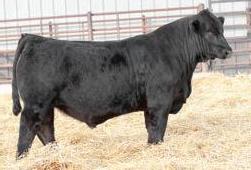

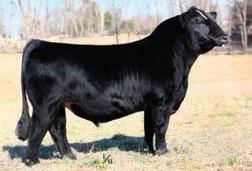
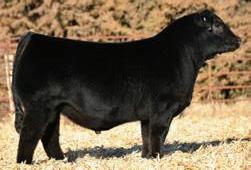
$API: 210 $TI: 107
CLRS Guardian 317G
Hook`s Beacon 56B x CLRS Always Xcellent ASA# 3563436 • Homo Black • Homo Polled Guardian was the $85,000 selection in the 2020 “Bred For Balance” Sale. He’s the breed’s #1 $API Purebred and #2 Marbling Purebred!
$API: 140 $TI: 86
CCS/WHF Ol` Son 48F
CDI Innovator 325D x WHF Summer 365C ASA# 3452997Homo Black Homo Polled Ol` Son is one of the newest and HOTTEST bulls on the market! Siring champs for JS Simmental in his first calf crop!
$API: 111 $TI: 72
Ruby/SWC Gentleman’s Jack
One Eyed Jack x Upgrade ASA# 3134708 • Homo Black • Homo Polled Producing extremely sound, deep-sided, highquality progeny! His first crop of heifer calves has produced champions at the highest levels!
$API: 125 $TI: 80
FRKG CKCC Platinum 009H ET
Mr CCF 20-20 x Profit ASA# 3809966 • Homo Black• Homo Polled Platinum is one the most talked about bulls of the season, topping the CK Cattle/Wager Sale at $175,000 for half interest! Described as “one of the true power bulls to surface within the last decade.”
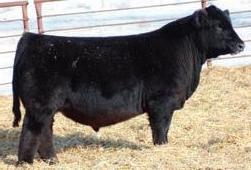
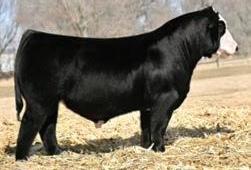
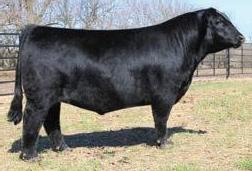
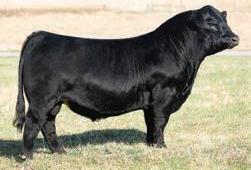
$API: 114 $TI: 77

H/C - W/C Fast Lane 9085G
Rubys Turnpike 771E x W/C Miss Werning A343 ASA# 3667480 • Homo Black • Homo Polled A popular feature in the 2020 NWSS Pen Show!
$API: 124 $TI: 78
W/C Bankroll 273H
PW/C Bankroll 811D x Hooks/ KS Sequoia ASA# 3808104 • Hetero • Black Homo Polled Griswold selected him at the $202,000 high seller at Wernings 2021 sale!
$API: 134 $TI: 80
W/C Express Lane 29G
Rubys Turnpike 771E x Hooks Shear Force 38K ASA# 3644933 • Homo Black • Homo Polled Complete Turnpike son at Western Cattle Source, NE!
$API: 97 $TI: 71
SWSN Cash Flow 81E
Profit x MR CCF Vision ASA# 3348420 • Black •Polled Cash Flow sired some of Hartman’s and Vogler’s high selling lots this past year!
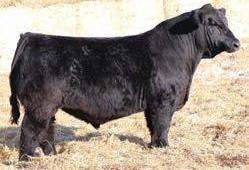
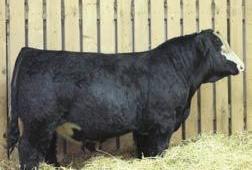
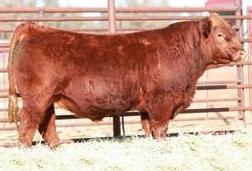
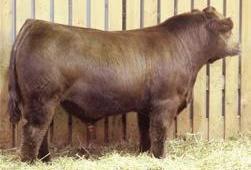

$API: 146 $TI: 101
SAS Infra-Red H804
All Aboard x Erixon Bitten ASA# 3803257 • Red • Homo Polled One of the hottest red bulls to sell in 2021!
$API: 131 $TI: 82
SAS Big Casino H214
Drake Poker Face x Erixon Bitten ASA# 3803217 • Homo Black • Homo Polled Big-bodied performance driven baldy!
$API: 184 $TI: 91
BAR CK D948 9153G
IR Imperial x CDI Verdict ASA# (3766616) • Homo polled High selling bull at BAR CKs 2021 Sale! Top 1%
$API: 167 $TI: 108
W/C Innovator 533H
CDI Innovator x WS Miss Sugar C4 ASA# 3808125 • Homo Black • Homo Polled Maternal brother to WS Proclamation and LCDR Impact and Favor. 533H is a power bull with a 1,500# YW.
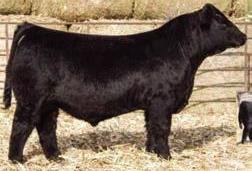
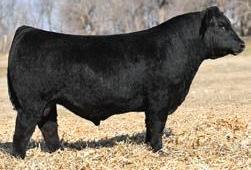
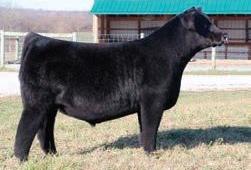
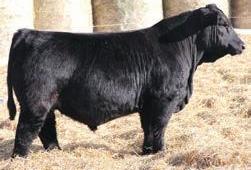
$API: 171 $TI: 101
W/C Innovator 9002H
CDI innovator x WS Miss Sugar C4 ASA# 3808126 • Homo Black • Homo Polled Maternal brother to WS Proclamation and LCDR Impact and Favor. 9002H is the CE leader Innovator son and higher $API.
$API: 154 $TI: 92
RBS 4254F H288
W/C Bankroll 4254F x RBS Uptown ASA# 3827413 • Hetero Black • Homo Polled Reck’s 2021 high seller to Hart’s, SD. Reck’s describe him as impressive a bull they’ve raised. 902# WW combined with excellent feet, joints and profile!
$API: 128 $TI: 82
CKCC Right Time 0639H
ES Right Time x WCS Mr Razor ASA# 3786555 • Homo Black • Homo Polled One of the few Right Time sons to be availble this season. He’s a powerfully constructed, heavy muscled 3/4 who was the second high seller at CK/Wager Sale.
$API: 101 $TI: 71
S&S TSSC Limitless 041H (1/2)
Conley No Limit x WS Revival ASA# 3776857 • Black • Polled Calf champion at 2020 NAILE!
by Emme Demmendaal
Editor’s Note: This article series highlights significant contributions of women in the Simmental community.
Former president for the American National CattleWomen, Penny Zimmerman, of One Penny Ranch, Foley, Minnesota, has been a lifelong Simmental breeder, beef advocate, and educator. Penny Zimmerman
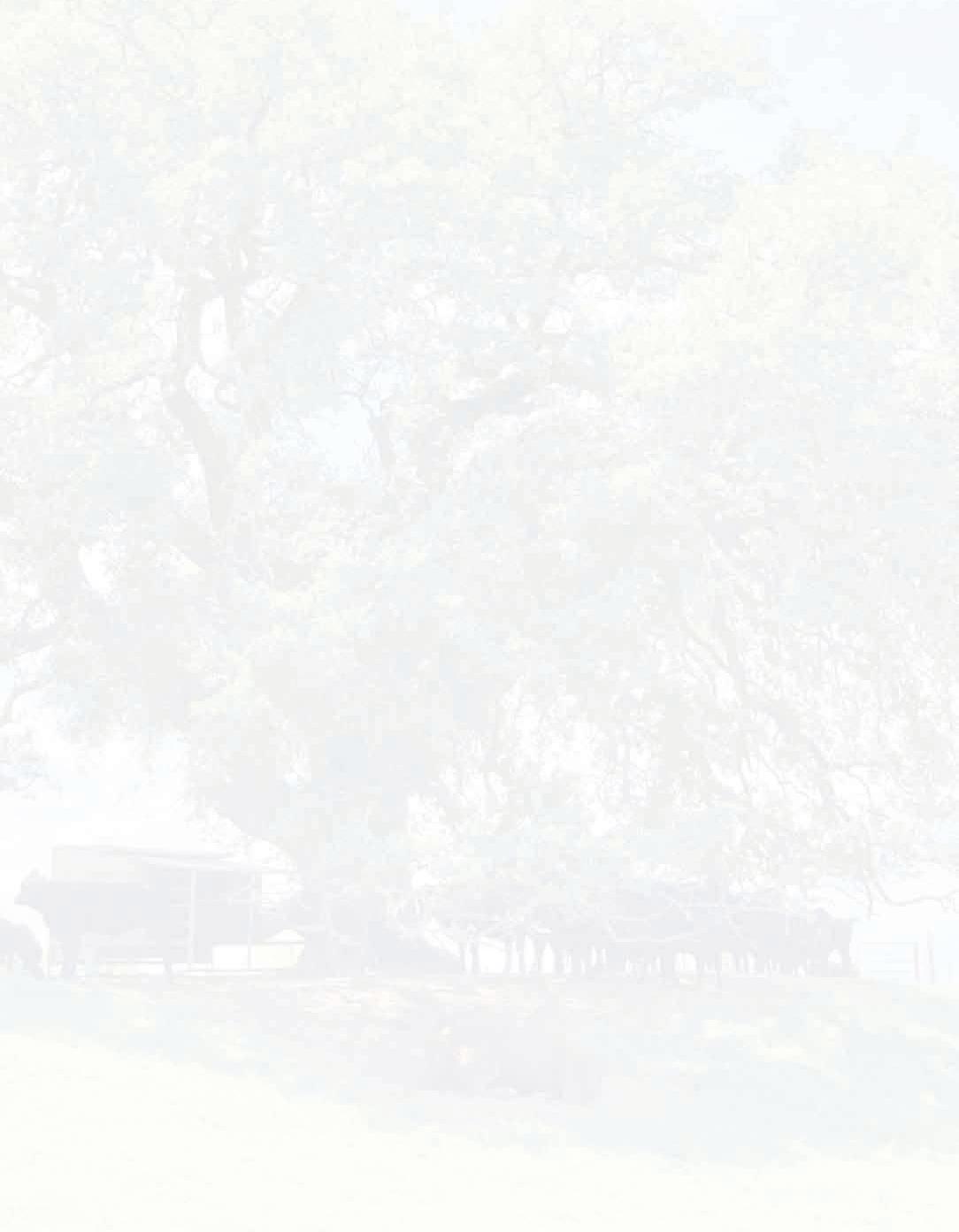
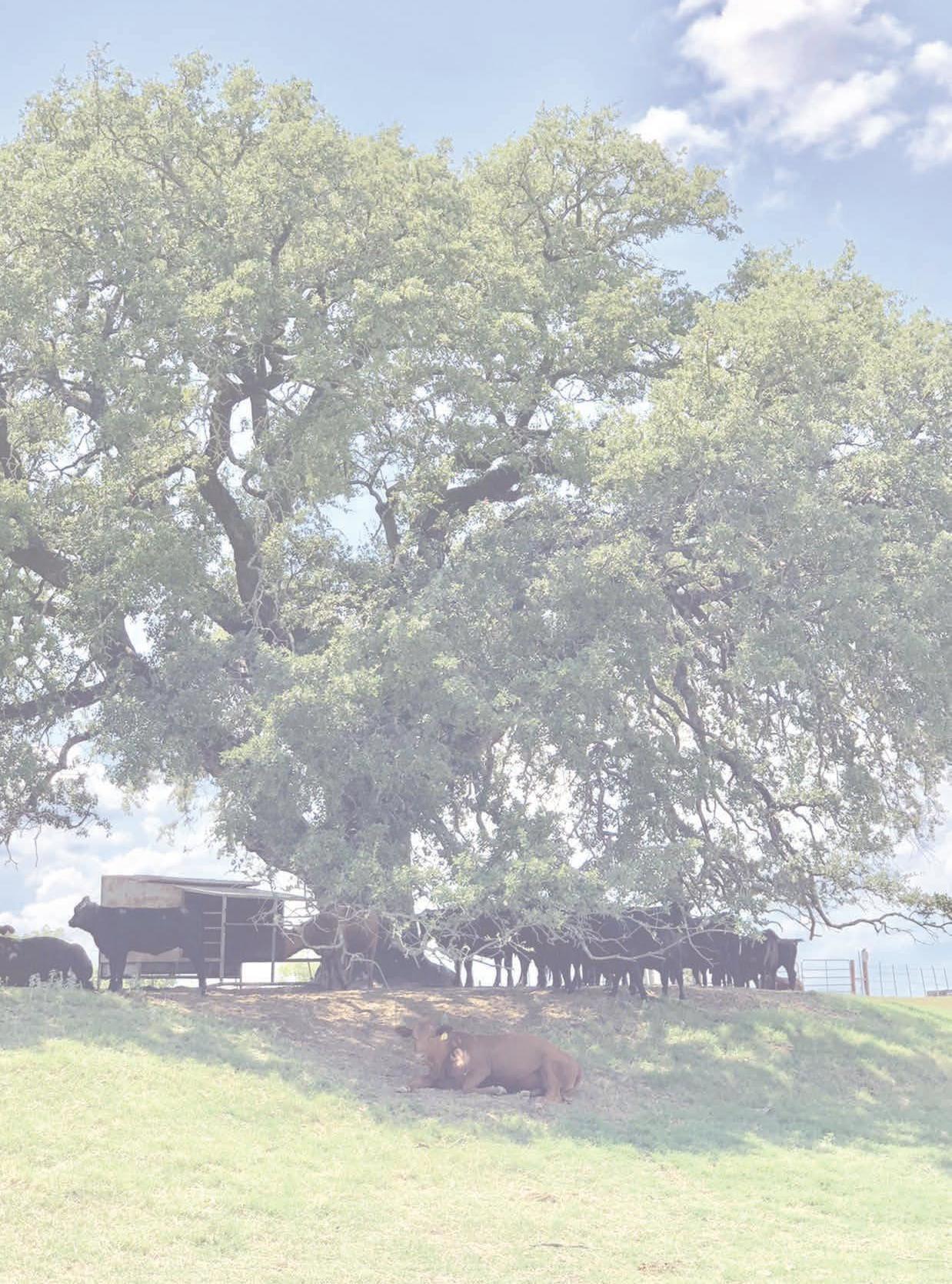
Breaking into the cattle industry as a first generation rancher can be difficult, but to also run a successful seedstock operation, while simultaneously making a positive impact for future generations through animal agriculture advocacy, sets the bar even higher. Penny Zimmerman, of One Penny Ranch located in Foley, Minnesota, is that cattlewoman. Growing up in the Minneapolis, Minnesota, suburbs, Zimmerman’s first experience with cattle was after she married. “When I married Bill, I thought I was marrying a city guy because he was raised in the suburbs of Indianapolis. But after we got married, I noticed these cattle magazines around the house. Soon after, we bought a couple of steers and needed to build a fence — just a little fence around about two or three acres of irrigated pasture.” She laughs, “But we lived in a little apartment, and we
Penny Zimmerman and didn’t have a place to store her husband, Bill. the leftover posts and leftover wire. So it was behind the couch in the living room. That’s when I knew I was in trouble.” When the couple moved to Southern Idaho, five miles north of Preston, Bill managed a Simmental ranch for Valdo Benson. It was here, experiencing life as a rancher, that Penny fell in love with the cattle industry. She recalls grazing the cattle in the mountains and bringing them back to the valley for winter calving, watching the calves grow to become mamas, and, like all ranchers, feeling the heartwrenching sadness when a few got ill and were lost.
“My husband introduced me to the cattle industry. I love being outside, being able to help with the chores, feed the animals, and watching the little calves play tag in the evenings when the sun is setting. It gives me a heartache when we treat sick calves and sometimes can’t save them. We are here to be good stewards of the land and good stewards of animals. It just all fits together.” She summarizes, “This is my life, and it’s exciting, from city girl to learning how to ranch and run cattle.” After living in Idaho, Utah, and Nevada, they settled back in Minnesota in the early 1980s and started their own Simmental operation. Today, One Penny Ranch is a diversified 150-head cow-calf and seedstock operation focusing on Simmental, SimAngus™, and Charolais genetics.
Zimmerman attended St. Cloud State University for teaching and taught third, fourth and fifth grades for almost 30 years. Zimmerman shares that she integrated agriculture and the cattle industry into the classroom every opportunity she got. “I taught at a school district that was part of a town outside the suburbs, and you would think that kids know more about farming, even if they live in town, because they drive past these corn, alfalfa, and soybean fields, but they really didn't know very much. It was interesting to be able to teach them a little bit about agriculture.”
Around 2000, Zimmerman started getting involved in the cattle industry organizations. She was introduced to the Minnesota CattleWomen (MCW), for which she was president from 2010–2012, and later the American National CattleWomen, where she went on to serve as ANCW president in 2017. “I traveled to 23 different states as president of ANCW, meeting with the cattlewomen at their state annual conventions. It was a really great experience to meet women in the industry and educate others about the industry.”
Recently, Zimmerman was selected to join the Cattlemen’s Beef Promotion and Research Board (CBB), a 99-member board from across the country that determines how the check-off dollar is spent. As co-chair for the CBB’s International Marketing Committee, Zimmerman, along with the committee members, has been focusing on driving US beef demand in other countries. She says, “Our goal is to understand what’s happening in different cultures around the world and improve interest in importing United States beef. We’ve increased the value of the carcass across the board by focusing on selling parts like tongue, liver, or tripe.”
At the end of the day, Zimmerman is passionate about helping people in and out of animal agriculture make informed decisions. She believes that education in the cattle industry and with the general public will make a larger impact in keeping the tradition of ranching and farming alive. She concludes, “I believe being involved helps to keep the cattle industry strong for the next generation. There are so many people in the US and the world who don’t understand our industry and would just as soon shut it down. If we educate people about the industry, consumers will understand how we do things and why we do them.” ■
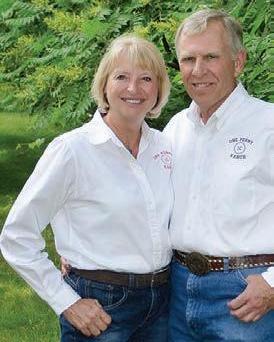

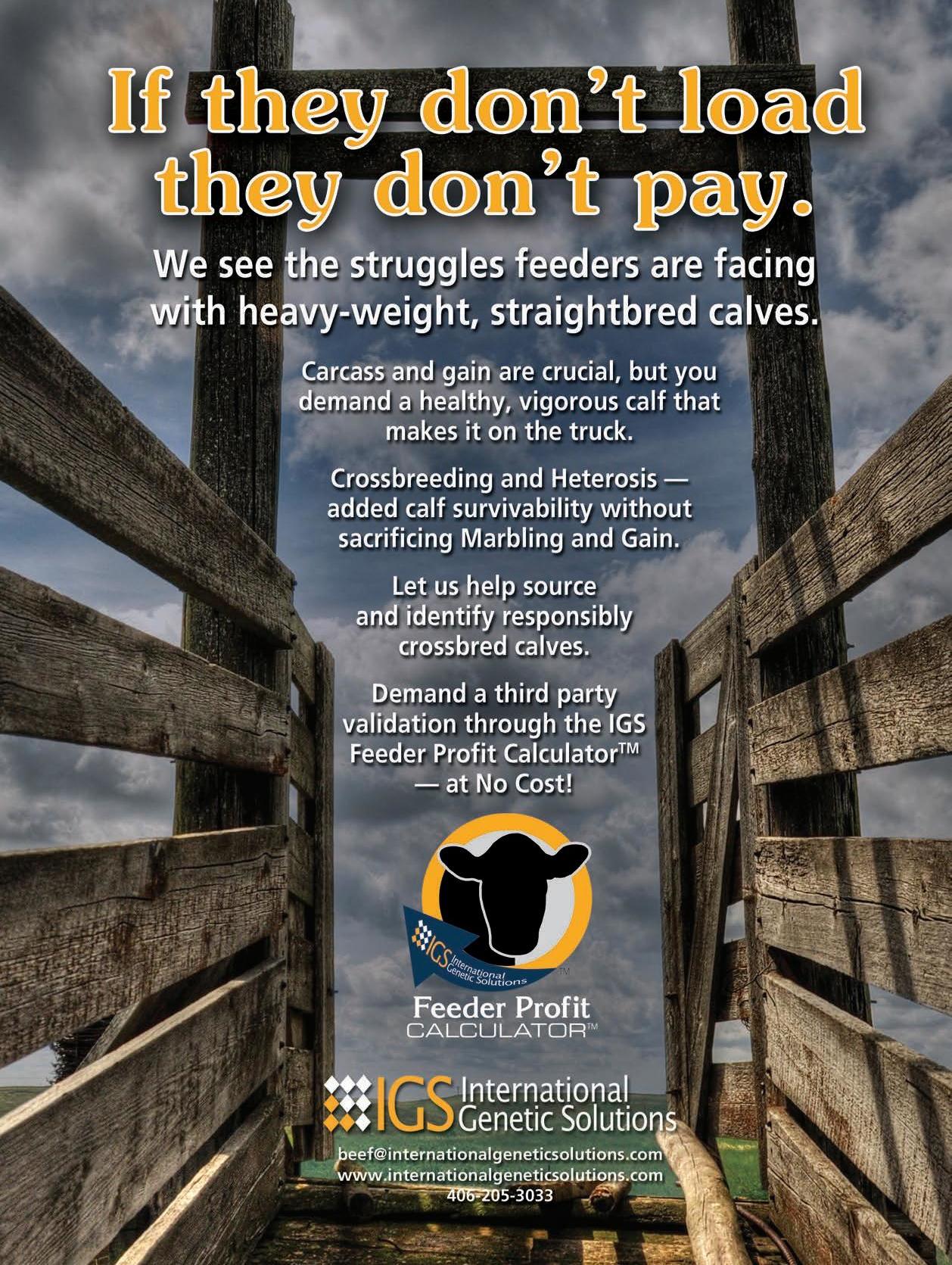
Hospital Builds on Former ASA Property
by Dan Rieder
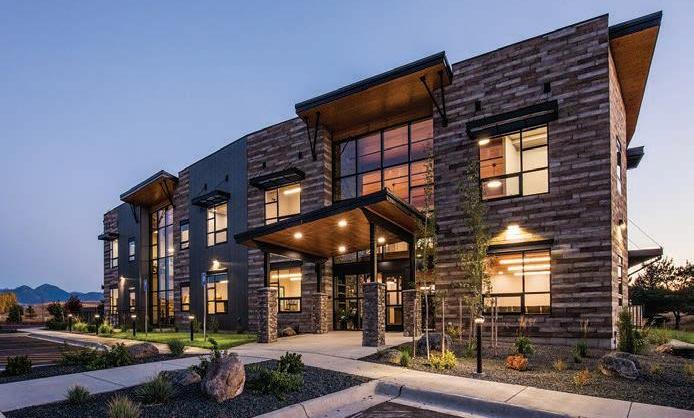
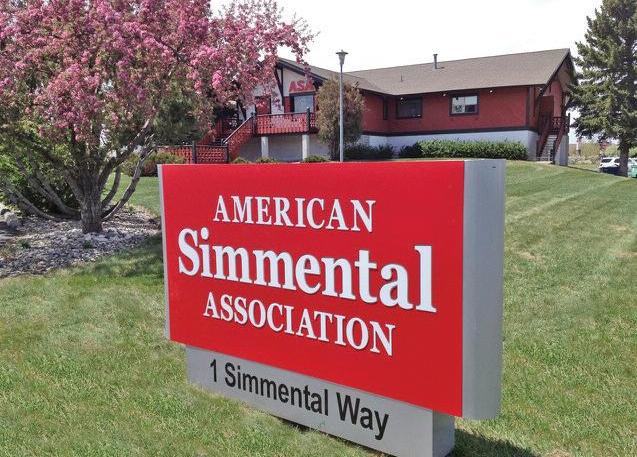
ASA’s original chalet-style building. ASA’s modern new building.
An artist’s rendition of Bozeman’s newest Urgent Care facility.
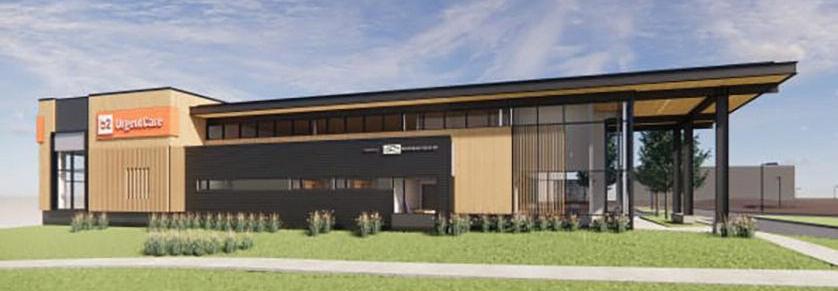
In 1974, the five-year-old American Simmental Association capitalized on rapidly expanding demand for its services to build an 11,250-square foot building costing $281,000. For 42 years, the Swiss chalet-style facility, nestled adjacent to heavily traveled Interstate 90, housed as many as 55 employees, along with a self-contained print shop, a completely equipped mail room, a constantly growing computer system, a waterproof walk-in safe, and a board room that converted to a small theater for slideshows and informational movies.
“In the mid-2010s, Bozeman was in the midst of a growth explosion and the demand for well-located property presented a win-win opportunity for the Association,” ASA Executive Vice President Wade Shafer explained. “We received an offer from a speculator on our existing property that was well above any expectations we might have had, setting in motion a plan that greatly benefited the Association.”
The original 40-year-old building was in need of a sizable injection of cash for maintenance and remodeling to bring it up to code. “This was a business opportunity that we just couldn’t afford to pass up,” Shafer emphasized. The Association then purchased 4.3 acres of land about one mile north of the original property and promptly constructed a modern, state-of-the-art office building. The new facility consists of 16,124 square feet on three levels. Total cost, including land, building, and planning, added up to $3.3 million, allowing ASA to place a welcome infusion of excess money in savings.
In February this year, the old building and a freestanding storage building were razed to make way for new construction.
A new building, called b2 UrgentCare on North 19th, is going up under the auspices of Bozeman Health, the local hospital that serves more than 150,000 people from a 100-mile radius. In an announcement, medical officials described the addition: “The building will open on Bozeman Health-owned land between North 19th and Simmental Way next to a rest area. The location provides convenient access to Urgent Care services for those traveling on I-90 and to the growing northwest side of Bozeman.” Construction will begin this summer and is expected to be fully complete by fall of 2022. “We are very pleased with the way these transactions played out,” Shafer concluded. “We have a new state-ofthe-art building with stunning views of the Bridger Mountains and additional land for future expansion or sale, while adding a substantial sum to our investment portfolio. The icing on the cake is that our original property will be utilized to provide much-needed health care to the rapidly growing population of Bozeman.” ■
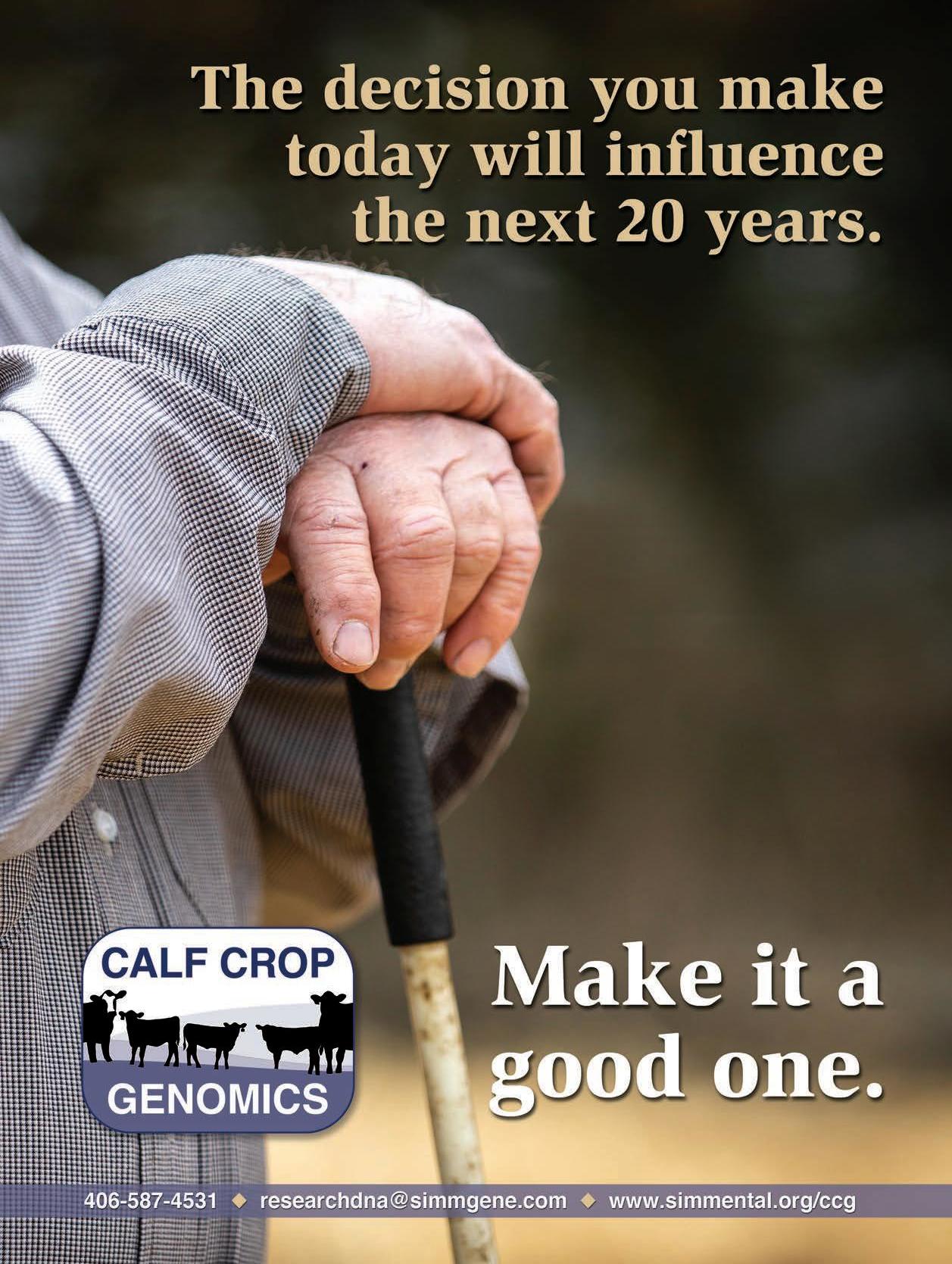
Platts: What are you considering as you step into the role of Board Chairman? Moody: As I step into the role as chairman in the midst of the global COVID-19 pandemic, one may think our challenge is to simply stay in business until we conquer this horrible virus; however, I see a bright future for the American Simmental Association. The task at hand is not to survive but to THRIVE. We are experiencing tremendous growth and acceptance in all segments of the cattle markets.
We have many great projects well underway. I would like to see us continue these, as well as show results from these projects. I am very aware that research takes time, but on the other hand, we must be able to relay results to our membership in a timely fashion. If I had to choose one thing I would like to hang my hat on as an accomplishment this year, it would be the long range planning of our Association. I am thinking not of the committee work, but more about the sustainability of our Association as a whole. I see it being imperative to do long range planning to ensure that the next generation of ranchers, ASA, and International Genetic Solutions, will be at the forefront, leading the cattle industry by continually making economic advances.
Diversity is of utmost importance, especially when speaking about the composition of the Board of Trustees. With many different interests under the large tent we call ASA, diversity among trustees is essential to remain focused on the betterment of all members and their customers.
One of the most important and difficult assignments that the incoming chairman is tasked with is selecting committee chairmen and making committee appointments. It is critical to make good decisions when selecting the makeup of each committee. I feel if that job is fulfilled correctly the participation of trustees will be there. Having a balance of newly elected trustees and experienced trustees enables all to glean from one another.
Platts: How do you view International Genetics Solutions (IGS), and its role in the industry? Moody: IGS has literally blossomed before our eyes in the years that I have been on the board. IGS is the philosophy of collaboration among many entities within the beef cattle industry. We cannot argue that each of the IGS partners have had significant impacts on the beef industry, but we can certainly see the power when these separate groups collaborate with one another. It is through this effort, with the leadership coming from ASA, that we have had the largest genetic evaluation of beef cattle in the world for the last five years.
This Multi-breed Genetic Evaluation is something all breeders can be extremely proud of. It is because of the evaluation we can study our animals and make confident, sound breeding decisions centered around individual goals.
I like to think outside of the box at times, and concerning the question of where ASA can grow, I think IGS is one area that should generate much thought. To be brief, I see the IGS platform creating a revenue stream by providing services to other partners beyond the scope of genetic evaluations.
At the same time, ASA/IGS should be offering our knowledge and services to the private business sector that have the commercial producers as clients. This may become a valuable revenue stream as well. We all realize the producers are only willing to invest in what is economically feasible, the key word being feasible. ASA/IGS has the ability to provide so much data about your cow herd that it’s easy to justify some added cost of production.
Platts: Total Herd Enrollment (THE), has been a part of ASA’s programs for many years now. How do you see this program in the future? Moody: Total Herd Enrollment has had a huge positive impact on ASA in a couple of ways. Putting on my business management hat for a moment here, THE came along when “cash flow” at ASA meant waiting until the end of the month hoping we could pay our bills. It was the idea of THE and the scheduled payments of participating in this program that allowed ASA to actually forecast expected income. This is huge in the business world. The accounts receivable department can breathe today being able to predict this part of our business.
THE is also a vehicle used to bring in more than 80% of the data points within our Herdbook. Also, the quality of this THE data has significant value because it is complete reporting of an individual’s herd. Updating the criteria for Performance Advocate will generate additional data collection, which in turn builds a stronger, more comprehensive database.
Platts: What role does the Carcass Merit Program (CMP) play? Moody: The CMP allows breeders to prove young sires. I see this program today being important because the actual carcass of known sires’ progeny validates our prediction of carcass quality traits. The carcass expansion program will further validate our predictions in a much faster timeframe simply because of the greater numbers of carcass reports. All breeders large and small will benefit from these programs.
Platts: ASA’s Progress Through Performance (PTP) program is an industry-leading way to combine the show ring and performance. How have you seen this evolve? Moody: ASA’s PTP program contributes to breed improvement. This is accomplished by placing the numbers (Continued on page 26)
(continued from page 25)
in the judge’s hands. I realize judges, like all of us, have opinions about which numbers may be more valuable than others. However, the real prize here is the exhibitors know the judges have the numbers and they make breeding decisions based on this fact, which ultimately will have a positive influence on the breed. The Ring of Champions program has created a new level of excitement among the exhibitors at the major shows. The take-home message we all need to understand is the cattle shows all across the country, from the small county fair to the major national shows, are our billboard for Simmental cattle paid for by the exhibitors. Even if you have never been in a show ring, your neighbor may have seen a Simmental animal at one of these shows and remember you having Simmental cattle. Just think. An exhibitor from Alabama shows an animal in Denver, someone from California sees it and goes home and thinks of his neighbor who has Simmental cattle and gives him a call. Now that is a cool opportunity.
Platts: DNA technology is expanding and offering new opportunities for producers. What role do you see this technology playing in the future? Moody: The implementation of DNA markers to the cattle industry has moved our ability to accurately predict individual traits forward at warp speed. With genomic testing we now have EPDs of a calf with the same accuracy as having the data results from 20 progeny.
This high-accuracy prediction was made possible in part by ASA’s Cow Herd DNA Roundup (CHR). Before CHR we had a fair amount of genotypes on bulls but very few records on mature cows. The CHR program gave ASA a huge increase in these much needed genotypes. As the genotypes continue to come into our database, the accuracy of everyone’s animals’ EPDs will continue to increase. Platts: Fostering youth involvement in the Simmental breed has been a priority for many years. What is your assessment of the AJSA? Moody: The American Junior Simmental Association (AJSA) is ranked as one of the best among all breed associations. The AJSA program is the critical lifeblood to the future of ASA. Our juniors are truly remarkable; just look at the 2020 National Classic. This was the largest National Classic ASA has seen, and in the middle of a pandemic. We not only saw the largest number of participants, but also the largest number of animals entered.
Our hats are off to the entire staff for their tireless work to pull off such an excellent event.
My message here: stay tuned! I look to see great things coming from our juniors. I hope to see you in Grand Island, Nebraska, this summer for the 2021 National Classic.
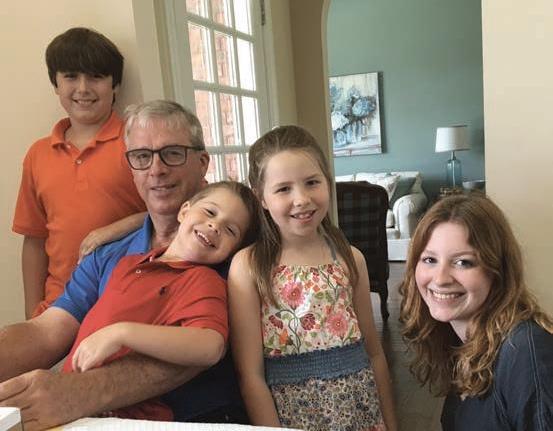
The Moodys are the proud grandparents of four grandchildren
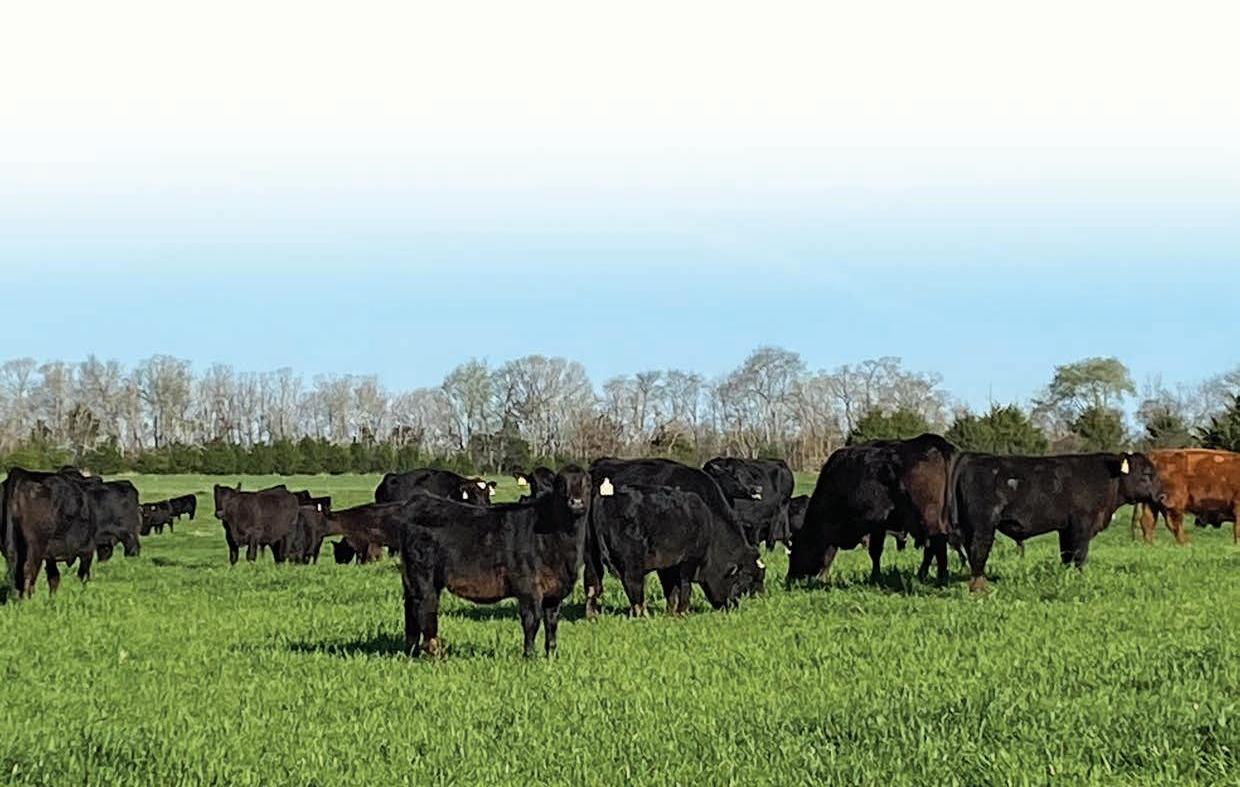
Platts: Comment on the importance of the ASA Foundation. Moody: The American Simmental-Simbrah Foundation is something that should be promoted each time you have the opportunity to talk Simmental. Our Foundation has four main pillars: education, research, youth and general. The Foundation Board is a working board, charged to raise funds for all four pillars. The Merit Award scholarships are 100% funded from the youth pillar, Fall Focus receives substantial funding from the education pillar, and there are research projects that the Foundation supports. I challenge each member to look at the good work generated from our Foundation and make a serious pledge to support the continued efforts of this Foundation.
Platts: The Simmental breed has a long history of involved state associations. What role do you see these localized groups playing for ASA? Moody: Our state associations are an absolute must in the overall structure of ASA. The state associations know their region best, and what needs to be done to promote SimGenetics in their state. Also, the state associations are the best place to get acquainted with ASA and how it functions.
Platts: As Board Chairman, what role would you like to see members play in the decision making process? Moody: It is amazing to watch as great ideas and programs develop. One may think their idea or opinion does not have merit, but this could not be further from the truth. As you watch and study how research and other programs evolve, most start from a casual conversation, and ask, “do you think this is possible?” Most of the time this conversation is in the hallway of a meeting. We need you in the hallways of our meeting asking the question, “is this possible?”
Platts: Technology is continually changing the way we communicate. How can we balance staying up-to-date with giving members the information they need through ASA’s publications? Moody: In this electronic age, one may question the future of our printed publications. My thoughts are, as long as our publications are printed and designed in the format that we know today, they will have their place. I consider the Register to be a coffee table book that stays for a month until the next issue takes its place. Also, there is a certain population that just likes to have the publication in their hands to read. ■
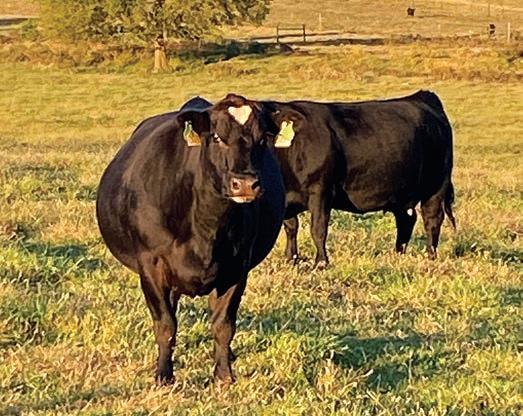
Little Mountain Farm runs Simmental, SimAngus™, and Angus females.
Little Mountain Farm was established in 1997 and has been focused on raising high-quality registered Simmental seedstock
Moody exclusively uses AI and ET work in his breeding program.
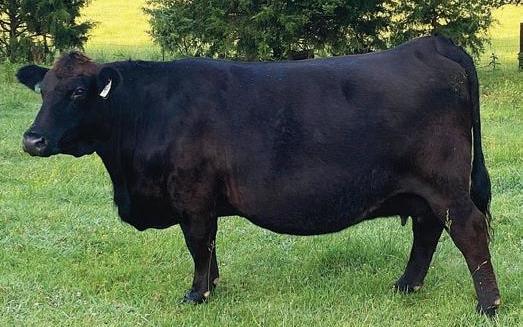
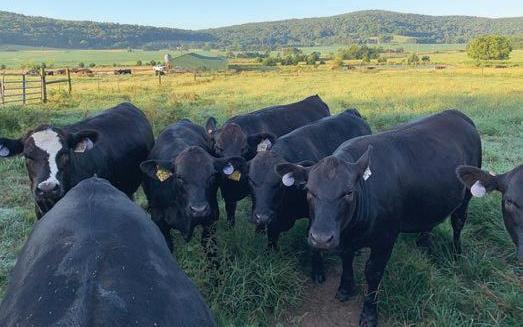

If you participate in Total Herd Enrollment, you could qualify as a Performance Advocate
For over a decade, the Performance Advocate program has recognized cattle producers who remain committed to data reporting. The 2021 program marks the second year with new guidelines to identify top-notch data reporting that fuels ASA’s genetic evaluation. Focused on submitting records on at least 90% of the contemporary group, a Dedicated Performance Advocate submits records on at least 8 of the 14 traits and a Driven Performance Advocate submits records on at least 10 of the 14 traits. Performance Advocates will be listed in the Late Fall issue of SimTalk for the fall 2019 and spring 2020 calf crops. These herds achieved the benchmark of being highly driven to data recording and reporting to ensure the most accurate prediction on their herd from the genetic evaluation to make more informed selection decisions for themselves and their customers.
–Fine tune the genetic differences in each calf crop. –Make better selection decisions, faster. –Submit calving and dam records. –Be a Performance Advocate and get recognized.
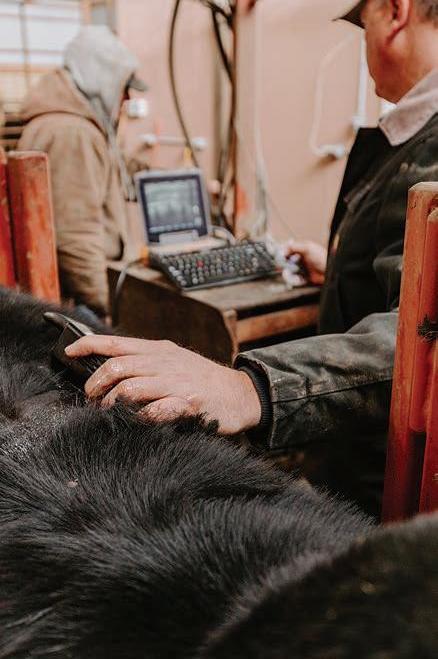
Traits Reported to ASA:
■ Calving ease ■ Birth weight ■ Weaning weight ■ Yearling weight ■ Yearling hip height ■ Ultrasound/Carcass ■ Docility scores ■ Genomic test on birth group ■ Foot and leg score ■ Mature cow weight ■ Mature cow body condition or mature cow hip height ■ Cow herd genomics ■ Udder score ■ Feed intake data (coming soon)
Are you already in Total Herd Enrollment? Go to page 10 to learn more about submitting your data to qualify as a Performance Advocate. All the data for fall 2019 and spring 2020 calf crops must be in by August 1. ■
